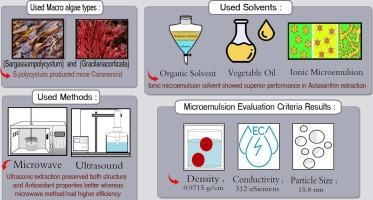超声波和微波工艺优化红、褐大藻虾青素提取工艺
IF 9.7
1区 化学
Q1 ACOUSTICS
引用次数: 0
摘要
本研究旨在通过有机溶剂(乙醇和乙酸乙酯的混合物)、绿色溶剂(水中三丁基辛基溴化磷离子液体的微乳液(MEL))和植物油(葵花籽油),优化微波和超声辅助提取虾青素(ASX)的工艺条件。首先,从密度、粒径和电导率等方面对MELs进行了评价。然后通过测定总类胡萝卜素、ASX含量、ASX提取效率和DPPH清除活性来评价不同提取方法的性能。结果表明,MEL的密度为0.97 g/cm3,直径为15.80 nm, 27.1℃时电导率为312µS/cm。结果表明,超声波从SP和GC中提取ASX的最佳条件为:液料比20:1,功率200 W,时间30 min;微波处理时,溶剂与样品的比例为20:1,功率为100 W,时间为5 s。结果表明,在两种方法中,离子MEL溶剂在ASX提取方面表现出更好的性能,SP提取的总类胡萝卜素比GC提取的多。微波处理从褐藻中提取ASX更有效,因为它能够从内部快速破坏细胞,改善溶质-溶剂相互作用,并且比超声波更有效地克服藻类组织的结构抗性。综上所述,红色(GC)和棕色(SP)大藻可作为提取虾青素和生物活性物质等有价值物质的廉价来源。本文章由计算机程序翻译,如有差异,请以英文原文为准。

Optimization of astaxanthin extraction from red (Gracilaria corticata) and brown (Sargassum polycystum) macroalgae through ultrasonication and microwave processing
This study aimed at optimizing the extraction of astaxanthin (ASX) by microwave- and ultrasound-assisted methods through an organic solvent (a mixture of ethanol and ethyl acetate), a green solvent (a microemulsion (MEL) of tributyloctylphosphonium bromide ionic liquid in water), and a vegetable oil (sunflower oil) from red (Gracilaria corticate/GC) and brown (Sargassum polycystum/SP) macroalgae. First, MELs were evaluated in terms of density, particle size and conductivity. Then, total carotenoids, ASX content, ASX extraction efficiency and DPPH scavenging activity were measured to evaluate the performance of different extraction methods. According to the results, the density of MEL was 0.97 g/cm3, its diameter was 15.80 nm and the conductivity was 312 µS/cm at 27.1 °C. Based on our findings, the optimal conditions for the extraction of ASX from SP and GC by sonication were the solvent to sample ratio of 20:1, power of 200 W and time of 30 min; for microwave processing, the solvent to sample ratio of 20:1, power of 100 W and time of 5 s. The results showed that in both methods, the ionic MEL solvent showed better performance in terms of ASX extraction, and SP resulted in more total carotenoids compared to GC. Microwave treatment was more effective for extracting ASX from brown algae due to its ability to rapidly disrupt cells from the inside, improve solute–solvent interactions, and overcome structural resistance of algal tissues more efficiently than sonication. Based on the results, red (GC) and brown (SP) macroalgae can be suggested as accessible and inexpensive sources for extracting valuable compounds such as bioactives and the natural pigment astaxanthin.
求助全文
通过发布文献求助,成功后即可免费获取论文全文。
去求助
来源期刊

Ultrasonics Sonochemistry
化学-化学综合
CiteScore
15.80
自引率
11.90%
发文量
361
审稿时长
59 days
期刊介绍:
Ultrasonics Sonochemistry stands as a premier international journal dedicated to the publication of high-quality research articles primarily focusing on chemical reactions and reactors induced by ultrasonic waves, known as sonochemistry. Beyond chemical reactions, the journal also welcomes contributions related to cavitation-induced events and processing, including sonoluminescence, and the transformation of materials on chemical, physical, and biological levels.
Since its inception in 1994, Ultrasonics Sonochemistry has consistently maintained a top ranking in the "Acoustics" category, reflecting its esteemed reputation in the field. The journal publishes exceptional papers covering various areas of ultrasonics and sonochemistry. Its contributions are highly regarded by both academia and industry stakeholders, demonstrating its relevance and impact in advancing research and innovation.
 求助内容:
求助内容: 应助结果提醒方式:
应助结果提醒方式:


